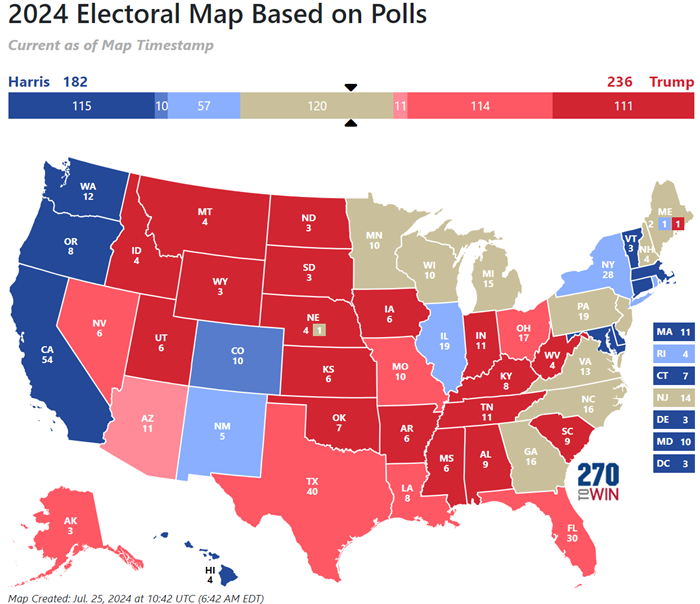After notching a string of wins in crucial swing states, Donald Trump was poised to return to the White House after a momentous presidential election in which democracy itself had been at stake and which is likely to take the United States into uncharted political waters.
The Republican nominee took North Carolina surprisingly early, the first battleground state to be called, and later he took Georgia and then Pennsylvania. He was strongly positioned in Arizona and Nevada, other key contests.
The race between Trump, a former president, and the current Democratic vice-president, Kamala Harris, had been a frenetic contest and it finally approached its conclusion amid scenes of celebration in the Trump camp.
At 1.20am, at Trump’s election watch party in Palm Beach, Florida, a prolonged, almighty roar went up as Fox News had called Pennsylvania for Trump. “It’s over!” screamed one man, amid the noise, at what felt like the point of no return. A young man in a black Trump hat shouted: “Fuck Joe Biden! Fuck her!”
The euphoric crowd chanted: “USA! USA!” They gathered near the stage, waiting for Trump to speak.
At 1.47am, Fox named Trump president-elect, though the Associated Press – which the Guardian follows – has not yet put Trump over the finish line.
The man who incited the deadly attack at the US Capitol on 6 January 2021, earning (and surviving) a second impeachment; the man who was this year convicted on 34 criminal charges; the man who faces multiple other criminal counts and who has been ordered to pay millions in multiple civil lawsuits, including one over a rape claim a judge deemed “substantially true”. The man at the centre of all of that whom senior military aides called a fascist and a danger to the republic was preparing to head for the White House again.
Eventually, past 2am, Trump emerged to speak, to the strains of God Bless the USA, the Lee Greenwood country anthem plastered on Bibles that Trump hawks for sale. Trump was surrounded by his family, by close aides, and by JD Vance, the hard-right Ohio senator he made his vice-presidential pick.
“This is a movement like nobody’s ever seen before,” Trump said. “This is I believe the greatest political movement of all time. There’s never been anything like this in this country and now it’s going to reach a new level of importance, because we’re going to help our country heal.
“We’re going to fix our borders. We’re going to fix everything about our country … I will not rest until we have delivered the strong, safe and prosperous America that our children deserve, this will truly be the golden age of America.”
Trump reveled in battleground state victories and said he would win them all. He claimed to have won the popular vote, which had not yet been decided. He described “a great feeling of love” and claimed “an unprecedented and powerful mandate”, celebrating Republicans retaking the Senate. He said it looked like Republicans would keep control of the House of Representatives – again, undecided at that point.
Trump saluted his wife, Melania, his family, and Vance, who he invited to the podium to speak. Vance buttered up the boss, promising “the greatest economic comeback in American history under Donald Trump’s leadership”.
Trump referred to the assassination attempts against him. “God spared me for a reason,” he said.
At Harris’s watch party, at Howard University in Washington, the mood became somber, as hopes Harris could become the first president from a Historically Black College and University began to flicker and dim. Around 1am, Cedric Richmond, a former congressman and Harris campaign co-chair, told supporters they would not hear from Harris.
“Thank you for believing in the promise of America,” Richmond said. “We still have votes to count. We still have states that have not been called yet. We will continue overnight to fight to make sure that every vote is counted, that every voice has spoken.”
Attendees rushed out, the mood swinging to despair. Eight years after Trump defeated Hillary Clinton in a similar fashion, few attendees seemed surprised or shocked. Many declined to comment. “What more is there to say,” one woman shrugged as she shuffled out.
Strewn water bottles and other litter were all that was left after the crowd was gone.
Before 1am, the Republicans had retaken the Senate. A West Virginia seat went red as expected but the die was cast when Sherrod Brown, a long-serving progressive Democrat, was beaten in Ohio by Bernie Moreno, a car salesperson backed by Trump. Democrats had held the chamber 51-49. Other key races went right. In Maryland, Angela Alsobrooks provided a point of light for Democrats, joining Lisa Blunt Rochester, of Delaware, as the third and fourth Black women ever elected to the Senate.
The House remained contested, Democrats seeking to retake the chamber, to erect a bastion against a Republican White House and Senate. The House can hold a president to account but the Senate controls federal judicial appointments. Further rightwing consolidation of control of the supreme court, to which Trump appointed three hardliners between 2017 and 2021, looms large.
In June 2022, that Trump court removed the federal right to abortion. Campaigns for reproductive rights fueled Democratic electoral successes after that but on Tuesday such issues seemed to fall short of fueling the wave of support from suburban, Republican-leaning women Democrats had hoped for and pundits predicted.
A measure to enshrine abortion rights in the Florida constitution, which Democrats hoped would help boost turnout, fell short of the 60% needed for approval. Nebraska, won by Trump, voted to uphold its abortion ban, which outlaws the procedure after 12 weeks of pregnancy. Abortion-related measures did pass in New York, Maryland, Colorado, Missouri, Nevada and Arizona.
A huge gender gap opened. A CNN exit poll showed Harris up by 11 points among female voters, Trump up 10 among male voters. Other polls showed dominant concerns over the economy and democracy. According to the AP Votecast survey, four in 10 voters named the economy and jobs as the most important problem facing the country, a hopeful sign for Trump. Roughly half of voters cited the fate of democracy, a focal point of Harris’s campaign.
Wednesday will bring jitters in foreign capitals. Victory for Trump’s “America first” ethos can be expected to boost rightwing populists in Europe and elsewhere – and to place support for Ukraine in jeopardy as it fights Russian invaders.
At home, America lies divided. Harris centered her campaign on Trump’s autocratic threat while he ran a campaign fuelled by grievance, both personal and the perception of an ailing America, baselessly painting Biden and Harris as far-left figures wrecking the economy with inflation and identity politics. Though he was the subject of two assassination attempts, in Pennsylvania and Florida, he stoked huge divisions and widespread fears of violence.
Trump told supporters “I am your retribution” and threatened to prosecute political foes, journalists and others. He suggested turning the US military against “the enemy from within”. He put immigration and border security at the heart of his pitch, painting a picture of the US overrun by illegal immigration, with language that veered into outright racism and fearmongering. He referred to undocumented people as “animals” with “bad genes … poisoning the blood of our country”.
He vowed to stage the biggest deportation in US history, to replace thousands of federal workers with loyalists, to impose sweeping tariffs on allies and foes alike.
On election night, he said he would govern “by a simple motto: Promises made. Promises kept. We’re going to keep our promises. Nothing will stop me.”
Additional reporting by Sam Levine in Allentown, Pennsylvania, Hugo Lowell in West Palm Beach, Florida, and Asia Alexander in Washington DC
Read more of the Guardian’s 2024 US election coverage










